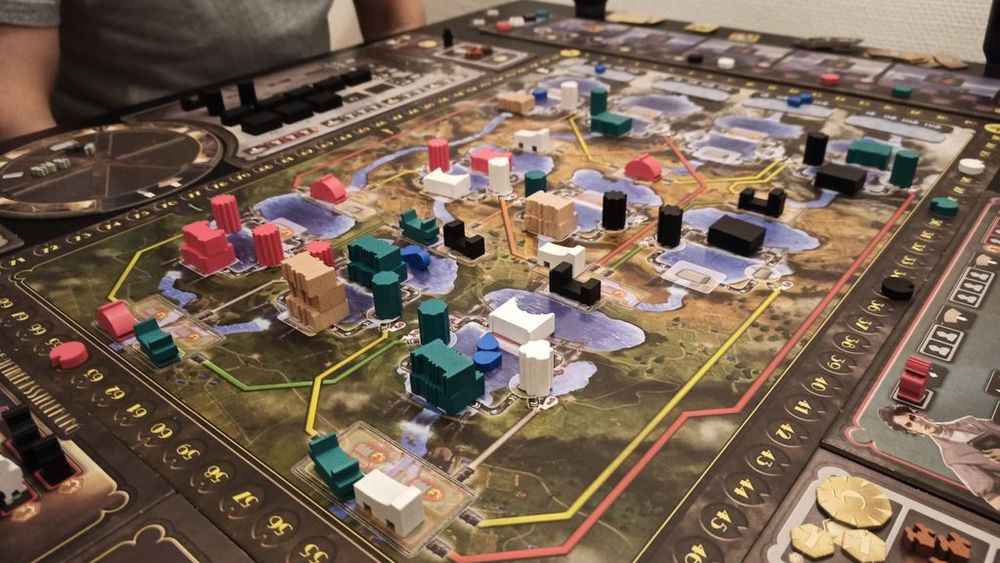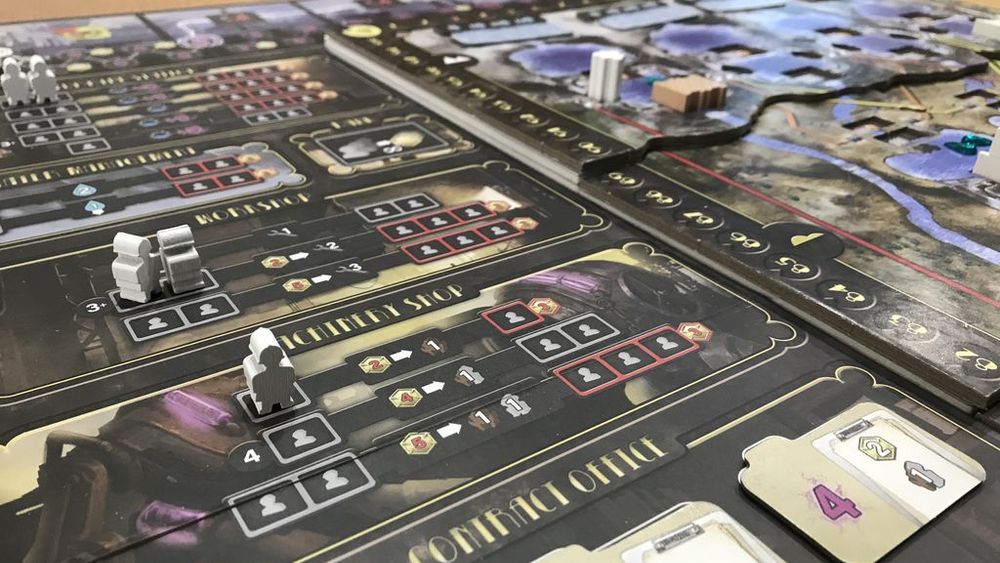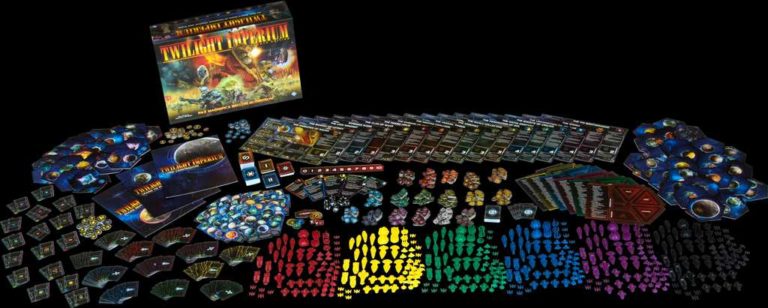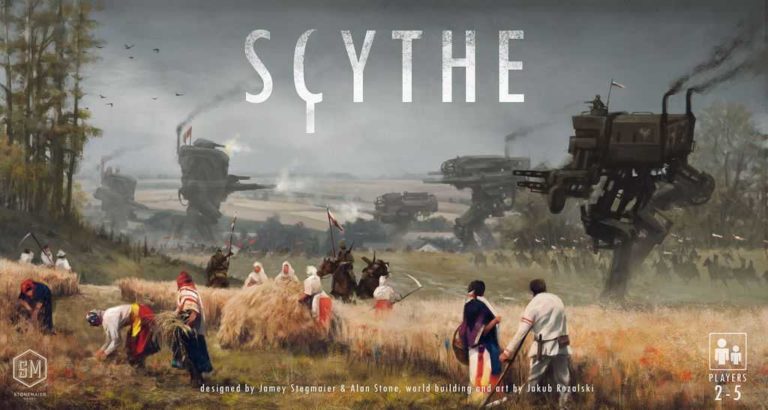Barrage Review: Board Game Triumph
Barrage Review: Board Game Triumph
Hey there, friend! I’ve got to tell you about this intense board game experience I recently had with Barrage. It’s a heavy strategy game that elevates the resource management genre to a whole new level. Every play feels like a high-caliber chess match, with water as a weapon. Picture a 1930s industrial landscape where you’re battling to master hydroelectric power, and you’ve got the essence of Barrage.
Key Points:
- Barrage is a heavy strategy game that elevates resource management to a new level.
- It offers deep strategic gameplay with intense competition and a learning curve.
- The game revolves around building an energy empire using water as a weapon.
- Barrage’s core mechanics and theme are intricately connected, with water as the lifeblood of strategies.
- The game’s components are thematic and visually striking, contributing to the immersive experience.
- Barrage demands careful planning, adaptability, and strategic wit, rewarding those who invest in learning its complexities.
- The game’s unique features include its water management system, aggressive player interaction, and construction wheel.
I remember the first game night; we were all novices, wide-eyed and buzzing with anticipation. We had heard that Barrage had deep strategy and a bit of a learning curve, but we were up for the challenge. It wasn’t long before we discovered that every decision mattered. The room was electric with the tension of trying to outmaneuver each other. Now, having played several times, I can’t help but dive deeper into the mechanics each session, reveling in the complexity and cutthroat competition.
It’s not a game for the faint of heart. My friends and I learned that making one wrong move could cascade into a torrent of troubles. There’s a spectrum of opinions about Barrage in the gaming community – some liken it to an elitist test of hardcore gaming prowess, while others feel it’s a brilliantly designed challenge that’s worth every minute of investment. In this Barrage review, let’s explore every aspect of the game, sharing some personal tales and expert insights along the way.
Diving into Barrage: A Board Game Overview
Barrage is not just another game on the shelf; it’s an intricate dance of strategic positioning and resource allocation. From the outset, you’re thrust into a race to build the best energy empire. To set the stage, I’ll guide you through the core concepts, the beautiful components that bring the game to life, and the dynamic gameplay that has intrigued and divided the board game community. Let’s get our feet wet, shall we?
The Essence of Barrage: Core Mechanics and Theme
Barrage is like a thunderstorm of gaming elements – it combines worker placement, resource management, and strategic planning in ways that can leave you both exhilarated and exhausted. Imagine the weight of each choice, as if you’re a 1930s energy mogul, harnessing the power of water to generate electricity for your burgeoning empire. The theme isn’t just a backdrop; it’s intricately connected to every aspect of gameplay.
Water is the lifeblood of your strategies in Barrage. Each round, you’ll navigate tough choices, from placing your workers to constructing dams, conduits, and powerhouses. The clever board design reflects the game’s central premise, where water flows downstream, turning turbines and illuminating cities as it goes. And therein lies the brilliance – the theme and mechanics are so well integrated, it feels like you’re truly part of this industrial revolution.
In Barrage, the integration of theme and mechanics creates a truly immersive gaming experience where every choice feels weighty and connected to the game’s central premise.
The Components and Setup: What’s in the Box?
When you first open the Barrage box, it’s like uncovering a trove of 1930s blueprints and machinery. The game is teeming with components that are both functional and thematic. You’ll find:

- A large main board that illustrates the mountainous region where your Hydroelectric empire will unfold
- Wooden components representing dams, powerhouses, and basins, so iconically chunky that they feel like actual miniatures of the structures
- A personal board for each player, acting as a maintenance chart and engineering workspace, where you’ll plot your rise to power
Setting up the game can be a bit daunting the first time. You’re constructing an engineering marvel from scratch, so expect lots of pieces and a game board that becomes a landscape before your eyes. Arranging your dams and conducting the flow of water captures the essence of being an industry magnate, and it’s thrilling every time pieces move from your personal board to start the energy generation process.
The Gameplay of Barrage
Diving into gameplay, Barrage feels like orchestrating a symphony, where every move must be harmonious yet calculated for your energy empire to flourish. The game unfolds over five intense rounds, with players vying to produce the most electricity by creating a network of dams, stations, and conduits to harness the power of flowing water. Trust me when I say that strategy is key, and each decision feels as crucial as placing the last piece in a complex puzzle.
The Strategic Depth of Resource Management
Now let’s talk about a pivotal element of Barrage – resource management. This game practically runs on the currency of concrete, excavators, and machine parts. You’ll constantly feel like you’re on the edge of your seat, deciding how to allocate your scarce resources. Do you build a new dam, or upgrade your existing machinery for more efficient energy production?
In Barrage, resources are not only scarce, but they’re also cleverly cyclical. You’ll use machines and materials to build, and then, with a sigh of relief, see them return to your supply as the rounds progress and structures complete. I’ve learned that timing is everything; it’s like investing in the stock market of the 1930s, knowing when to splurge and when to save could make or break your energy enterprise.
The Role of Infrastructure and Technology in Gameplay
If resource management is the heart of Barrage, then infrastructure and technology are its soul. Building dams, conduits, and powerhouses are just the start; you have to plan it all like a master architect. Where you choose to build will affect not just your strategy but also the flow of the game – quite literally as the water streams downhill!
The technology track adds another layer of intrigue, offering you upgrades and capabilities to fine-tune your engineering feats. These decisions again exemplify the game’s strategic depth, as choosing which tech to pursue can significantly alter your path to victory. Forget autopilot; every game demands fresh tactics and a keen eye for synergies between your structures and tech advancements.
Player Interaction and Competition Dynamics
One thing I adore about Barrage is how it fosters player interaction. It’s not one of those games where everyone is locked in their own little world; here, you’re constantly surveying your opponents’ intentions, as you all draw from the same pool of actions and resources. The competition is fierce – like a tug-of-war over a limited supply of water.

Barrage’s player dynamics create a competitive atmosphere that’s not for the meek. You’ll need to be assertive to grab the choice spots for your dams, and sometimes you have to wrestle control from someone else’s grasp. In this game, every action has a reaction, and a well-placed dam can turn the flow of the game – sometimes to your favor, other times, well, let’s just say things can get stormy.
Barrage fosters intense player interaction, creating a competitive atmosphere where assertiveness is key and every action has a reaction.
The Design and Aesthetics of Barrage
The artistic design of Barrage is not something to be overlooked. It’s a visually striking game that successfully conjures the gritty feel of industrial expansion. Every component, every card, even the rulebook screams attention to detail. The aesthetics aren’t just there for show; they’re an integral part of immersing players into the game’s thematic universe.
Visuals and Artwork: Setting the Scene
Talk about a game that sets the scene! The artwork in Barrage is a masterclass in thematic design. The main board is a topographical marvel, a landscape waiting to be altered by the players’ will. The visuals are adeptly crafted to transport you to a time when industrial tycoons battled over resources and territories.
Even the player boards are mini works of art, with gauges and lever illustrations making you feel like you’re inside a control room, responsible for the energy of an entire region. This visual storytelling is not mere decoration; it enhances the gaming experience, drawing you deeper into the world of Barrage with every turn.
Quality of Components and Durability
A crucial aspect of any board game, particularly one as intricate as Barrage, is the quality of its components and their durability. Opening the box, each piece feels hefty and substantial, from thick cardboard tiles to solid wooden dams. There is an undeniable satisfaction to handling these components, placing them on the board with a reassuring solidity.
Yet, durability can sometimes be a concern with games that see heavy rotation on game nights. After many sessions, the components of my copy of Barrage have withstood the test of time, still looking ready to face many more battles over water rights and power. The creators have done a fantastic job ensuring that the game’s physical elements can survive the ebbs and flows of intense gaming sessions.
The durability and quality of Barrage’s components have been carefully designed to withstand heavy use and provide a satisfying gaming experience.
The Experience of Playing Barrage
Playing Barrage is like hiking up a steep trail; it’s challenging and can be exhausting, but reach the summit, and the view is breathtaking. The game presents a tough learning curve that may not appeal to everyone, but for those who stick with it, the sense of accomplishment is unparalleled. It’s a game that rewards careful planning, adaptability, and a bit of daring.
Learning Curve and Accessibility for New Players
Ah, Barrage. Just thinking about the first time I set it up brings back a wave of nostalgia and a tiny shiver of ‘what have I gotten myself into?’ It’s a beast of a game, to state it frankly, with a learning curve that might more closely resemble a mountain climb. Starting as a newcomer, you’ll feel the weight of its complexity within the first few turns – remembering that one of my friends, new to the hobby, was utterly bewildered, trying to grapple with the intertwining cogs of its resource management system. However, what’s truly fascinating, and where Barrage shows a hidden path to brilliance, is how it starts to click after a game or two. Stick with it, and you’ll find the dense rules giving way to an intensely satisfying strategic experience.

To its credit, if we compare Barrage with other heavy strategy games, it’s not entirely unforgiving to the uninitiated. It’s just that you won’t simply dip your toes; you’ll dive straight into the deep end. But isn’t that the mark of a masterful design? Think of it like the board game version of learning to play an intricate piece of classical music – it might be daunting at first and your initial recitals might lack flair, but once you get the hang of it, oh the symphonies you’ll conduct!
Replayability and Game Longevity
Let’s talk about one of the key strengths of Barrage: its replayability. This isn’t a game that you’ll tire of after a few sessions. Quite the opposite – its intricacies and depth mean that with each subsequent play, you’re peeling back another layer, discovering new strategies and interactions you hadn’t considered before. The varying objectives, technology tiles, and water management challenges keep each game feeling fresh – like you’re rolling out the blueprints for a new hydroelectric dam every time. In my gaming circle, the phrase goes, “another round of Barrage?” is met with the same anticipation as the season finale of your favorite show.
And longevity? Well, Barrage isn’t just a fleeting affair; it’s a game designed for the long haul. Lasting impressions stem from its ability to remain challenging and engaging months – no, years – after your first play. It’s as if the game’s construction is akin to the durable dams you build within it. Even with countless sessions under our belts, my group still debates strategies, and when you see a game foster such ongoing discussion, you know it has a special place on your shelf.
Not to mention, the community involvement with the game has certainly boosted its lifespan. Online forums, expansions, and a plethora of player-generated content have turned Barrage into much more than a game; it’s a dynamic ecosystem that grows and evolves with its players. And isn’t that just the core of a truly great board game?
Barrage’s replayability and longevity make it a game that continues to offer new strategies and interactions even after years of playing, fostering ongoing discussion and community involvement.
The Community and Support: Expansions and Variants
Even the most solitary board gamer can’t help but feel a warm sense of inclusion within the Barrage community. It’s vibrant and resourceful, with aficionados eager to share tips and strategies, discuss expansions and variants, and everyone seems to revel in the game’s cunning design. I’ve seen this firsthand at conventions where Barrage tables are often surrounded by a buzz of excitement and strategic pondering. There’s something about this intricate dance of water management that just brings people together.
Expansions, you ask? They’re not just add-ons; they’re transformative experiences! They introduce new mechanisms, storylines, and strategic opportunities that can make an already great game feel like an entirely new challenge. It’s a testament to the game’s solid foundation that the community not only eagerly consumes these new experiences but also contributes to them, offering custom scenarios and variant rules that are shared across the globe. It’s this sort of supportive environment that keeps a game like Barrage not merely alive but thriving.
Critical Analysis and Comparisons
Peering into the rich tapestry that is the world of heavy strategy games, Barrage presents a compelling, though intensely precise, gaming experience. I’ve mulled over countless board gaming sessions, and when I consider Barrage in the grand scheme, it’s clear that it demands your full attention and strategic wit. It sits in a unique niche, not just for its water flow mechanics but for how it merges cutthroat interaction with complex resource management. That’s why, in a critical analysis, it’s essential to compare apples with apples, and in this case, we’re dealing with a particularly juicy and intricate apple in Barrage.
Barrage vs. Other Heavy Strategy Games
As someone who’s tried many a game in the genre of heavy strategy, I can say that Barrage stands out like a dam on a river – impossible to ignore and imposing in its presence. It’s often been measured against the greats like Brass or Terra Mystica, where strategic depth and interaction are key. However, in Barrage, the ruthlessness and potential for take-that moments can outclass even these titans, particularly when engaging with experienced players. The comparisons are valid, yet after a few sessions, it’s clear that Barrage has carved out its own gap in the market; it offers a relentless blend of strategy and competition that few others can match.

The tight economic constraints and infrastructure planning differentiate it significantly from others. While a game like Brass emphasizes industrial revolution synergy, Barrage is less about synergy and more about engineering supremacy – making it feel like a heavyweight chess match where every move has profound implications. With the high degree of player interaction and potential for disruption, it’s no wonder the game can feel as volatile as the water currents it’s based upon.
Yet, it’s not for the faint-hearted. For those accustomed to euro-style games that allow for gradual development or correction of mistakes, Barrage can seem merciless. It has a way of rewarding strategic foresight and punishing even the slightest miscalculations, putting it in stark contrast with the often more forgiving economic simulations in the genre. This can result in elation for the victorious and, at times, an agonizing reevaluation of tactics for the not-so-fortunate.
Unique Features That Set Barrage Apart
Barrage truly does have its own identity within the world of board games, and this is accented by a few unique features that make it quite the experience. First and foremost is the water flow system – an unparalleled mechanic that captures the essence of hydroelectric power generation in a way that’s not just thematic, but influences every aspect of gameplay. This dynamic resource isn’t static, it moves, it shifts, affecting everything in its path, just as it would in the real world. It’s a stroke of genius that requires players to adapt as swiftly as the tides change.
Then there’s the construction wheel, a component that embodies a stroke of innovation. This rotating puzzle requires players to juggle time management, planning, and resource allocation all on a single, tangible piece of the game board. It’s a piece of engineering in itself, melding tactile presence with gameplay profundity – it’s not something you’ll find in your everyday board game, and that’s a fact.
Lastly, the level of direct competition and potential for what some would call ‘sabotage’ is unparalleled. In Barrage, you’re not only managing your own ambitious projects but also constantly eyeing your opponents’ strategies, looking for that one opening to cut off their water supply or swoop in and claim a critical location. This isn’t passive-aggressive euro gameplay; it’s full-throttle strategic warfare where every decision can alter the outcome of the game.
1. What makes Barrage stand out from other board games?
What makes Barrage stand out from other board games is its unique water management system, a feature that turns the natural resource of water into a dynamic, flowing element that players must deftly navigate. This complexity is underscored by the game’s aggressive player interaction, setting it apart as a game that’s as much about outsmarting your competition as it is about managing your own resources.
2. Is Barrage suitable for casual gamers?
Barrage may present a formidable challenge that might not align with the casual gamer’s preference for lighter, more quickly grasped experiences. However, for those who are willing to invest the time to scale the steep learning curve, Barrage offers a rewarding depth that could offer a satisfying transition into a heavier tier of board gaming.
3. How long does a typical game of Barrage take?
A typical game of Barrage takes anywhere between 1 to 2 hours, with the potential for longer sessions if players are particularly strategic with their planning and execution. The game’s depth and complexity require dedication and time, ensuring a rich gaming experience with each playthrough.

4. Are there any expansions available for Barrage?
Yes, there are expansions available for Barrage that build upon the base game and offer new gameplay elements, strategies, and challenges. These expansions enrich the game’s replayability and add layers of complexity for seasoned players seeking to enhance their gaming experience.
Conclusion
Reflecting on this Barrage review, it’s evident that Barrage is a titan in its category, a feat of design that has carved out a fervent following and a reputation for being as challenging as it is rewarding. Its replayability and longevity are without question, and the community and support for the game continue to propel it into classic status.
It’s been a joy to dissect Barrage, from its steep learning curve to its inspiring replayability and supportive community. The game has and will continue to imprint its mark on the board gaming community for its originality and formidable presence at the gaming table.
Where it stands, whether amongst other strategy giants or on its own merits, Barrage is a triumph of game design, one I’m always eager to return to, provided I’m ready for the mental workout it entails. And so, as I close this Barrage review, I’m reminded of the feeling of setting up the game, the anticipation of strategic skirmishes to come, and the satisfaction of mastering its turbulent waters. Here’s a question to captivate the thought of every reader: Have you weathered the Barrage yet?
Until our next gaming adventure, Lucas
More Boardgame Reviews:
This article uses material from BoardGameGeek and is licensed under the Creative Commons Attribution-Share Alike License.







